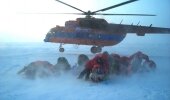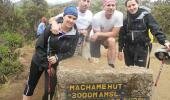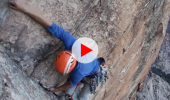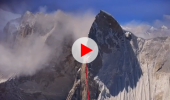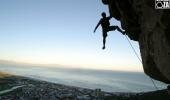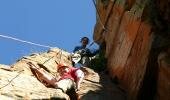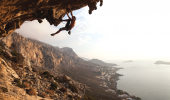Words: Kobus Bresler | Photos: Itchyfeet SA
“The trick is not to rid your stomach of butterflies, but to make them fly in formation.” - Anonymous
If you’ve been following the climbing articles in the previous two issues, and put what you've read into practise, then you are sure to have experienced some butterflies.
Those moments should put a big smile on your face and, in time, you will learn how to channel this into positive energy that is transferred into your new, favourite sport. And if you have followed all the steps closely, you should be well on your way to lead climbing. Hopefully you’ve been experiencing all the fun (especially those butterfly moments) that the sport can provide, but more importantly, I trust you have seen how safe climbing can be.
TOP ROPING
By now you should feel comfortable with top roping on artificial walls and natural rock. Even if you have not had time to visit any crags yet, please don't despair. Just keep following the progression and do not move off a level until YOU are comfortable. It is natural for some people to progress faster than others.
Gear
In the last issue, I recommended investing in a harness, helmet, belay device and locking carabiner. A harness is non-negotiable and you will need this every time you set out climbing, indoors and on the crags. A helmet is another non-negotiable for all the obvious safety reasons. Finding a belay device that you are comfortable with is essential and will help you become familiar with the correct and safe belay technique. If you have purchased this gear, I hope you remembered to ask for proper instruction and read all the safety and care instructions, as this will help you to get comfortable with using this equipment. It will become second nature as you use it more frequently.
Communication
Communication while climbing is essential for your safety and that of your partner. You need to develop a clear understanding of your roles and responsibilities so that you can focus more on your technique and enjoyment of the sport. Climbing calls are an essential part of this process and have developed into a universal language used by most responsible climbers.
You will develop your own language with your climbing partner, but it is essential to learn the more frequently used climbing calls. So the next time you are at the crag you won’t be completely lost when people start shouting terms at you.
Before starting your route, the following communication sequence is common practise.
Ready to climb, I'm ready, On belay, I have you on belay
Climbing, I'm starting to climb, Climb, Go ahead
From there, the following calls have been developed to facilitate clear communication between climbing partners.
• SLACK indicates that a little slack is needed in the rope. This may be to reverse a move, make a new move or unclip equipment.
• UP ROPE indicates that there is too much slack in the rope and the climber may feel insecure.
• TIGHT is called prior to making an awkward move or when the climber is expecting a fall. It indicates that the climber wants the rope almost completely tight for added security.
• SAFE is a call from the belayer after the climber asked for a tight rope to indicate that the rope is tight and is being watched. It is also used once the top of a climb is reached as a courtesy to your belayer.
• THAT’S ME is used by the climber to acknowledge that the slack is gone. It is an important call to learn as the belayer may not always be able to see you. In some situations yanking on the rope too much can pull you off the rock.
• FALLING is pretty self-explanatory and used frequently as you can often anticipate this while climbing.
• BELOW is a vital call to remember and used when accidentally dislodging a stone or object from the route. This call must be shouted in full volume, and once given those below should not look up to avoid injury. This is a clear reason why it makes sense to wear a helmet while belaying or sitting below an active route.
While climbing, it is important to know and understand these calls to eliminate any uncertainty and ensure a safer climbing experience. These calls should always be clarified before the start of a climb, and it is important that you call out loudly and clearly to avoid confusion. If you are on a busy crag or section, it is advisable to also use your climbing partner's name prior to giving your call.
Safety precautions
One of the main reasons why climbing is such a safe sport is because you have a partner with you that you hopefully trust. This provides an opportunity to double-check most things we do at the crag. Once the climber and belayer are tied in and set-up, both partners should check the set-up as follows:
1. Harness buckles must be doubled back, as per instruction and the harness leaflet.
2. Make sure all knots are properly tied and dressed.
3. All carabiners in the system must be properly aligned and locked.
These are all basic safety precautions that should become a part of your approach as soon as possible. Even the most experienced climbers will still ask their partners to check them from time to time because we are all fallible. It allows you to focus on the goal at hand and develop your climbing technique. Top roping allows you to focus on this technique and figure out your style of climbing in a safe and controlled situation. Additionally, it will open the way to harder grades and more refined techniques, which allows you to make those awkward moves.
Bouldering
Another great way to develop your climbing muscles and technique is bouldering. Bouldering is a style of rock climbing undertaken without a rope and normally limited to very short climbs. The safety is provided by a friend spotting you to brake any fall and, more often than not, a padded mat, called a crash pad, is used to avoid injury. Bouldering is typically practised on large natural boulders, but nowadays bouldering caves can be found at most indoor climbing gyms.
It is important to note though that bouldering has developed into a unique sport and even has its own grading system for routes. I have met numerous people that only boulder and are exceptionally good at it. For the purpose of our climbing progression, you will need to look at it as a training and development tool. In time, you may decide that bouldering is a pursuit you want to focus on and practise separately. If you decide to do this, it is important to invest in a crash pad for your own safety and enjoyment.
So far we have looked at some basic knots and equipment, with the biggest emphasis on safety and learning while having fun, as well as two fairly simple climbing styles, top roping and bouldering. If you have already progressed to sport or lead climbing, then you are learning quickly and are clearly very confident. However, my advice is to take it one step at a time and grow into the sport for all the reasons already discussed.
In the next issue we will look at lead climbing and additional equipment needed to practise the sport safely. So, get out (or in) climbing and play as often as possible. Until next time, have fun and be safe.
dinFO:
Top roping (or top rope climbing) is a style in climbing in which a rope, used for the climber's safety, runs from a belayer at the foot of a route through one or more carabiners connected to an anchor system at the top of the route and back down to the climber, attaching to the climber by means of a harness.
